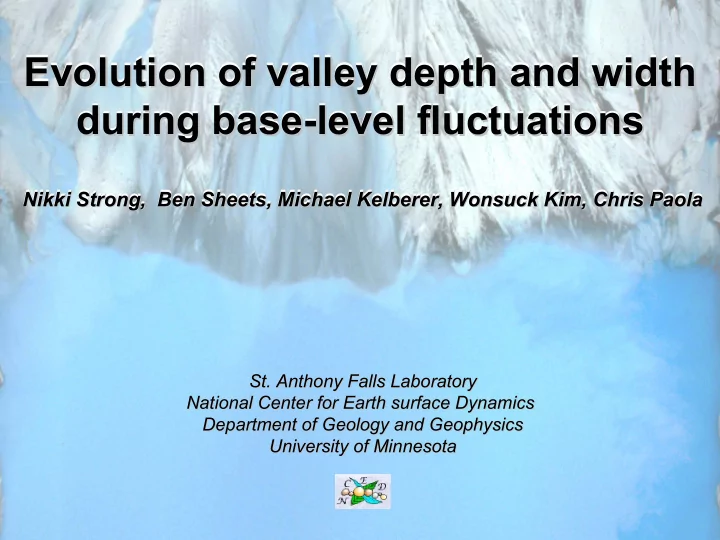

Evolution of valley depth and width Evolution of valley depth and width Evolution of valley depth and width Evolution of valley depth and width during base- -level fluctuations level fluctuations during base during base- -level fluctuations level fluctuations during base Nikki Strong, Ben Sheets, Michael Kelberer Kelberer, , Wonsuck Wonsuck Kim, Chris Paola Kim, Chris Paola Nikki Strong, Ben Sheets, Michael Nikki Strong, Ben Sheets, Michael Kelberer Kelberer, , Wonsuck Wonsuck Kim, Chris Paola Kim, Chris Paola Nikki Strong, Ben Sheets, Michael St. Anthony Falls Laboratory St. Anthony Falls Laboratory National Center for Earth surface Dynamics National Center for Earth surface Dynamics Department of Geology and Geophysics Department of Geology and Geophysics University of Minnesota University of Minnesota
1 1 Experimental Set- -up up Experimental Set 2 2 Experimental parameters Experimental parameters 3 3 General observations General observations 4 4 Temporal and spatial valley evolution Temporal and spatial valley evolution 5 5 Conclusions Conclusions
Experimental set- -up up Experimental set flow flow ~ 3 m ~ 3 m ~ 5 m ~ 5 m Plan view Plan view
flow flow Subsidence Subsidence
“Jurassic Tank Jurassic Tank ” ” Mechanics Mechanics “ transport surface experimental deposit gravel basement rubber membrane stainless steel cone solenoid valve pressurized water reservoir to water supply to gravel recycling
Basin Elevation Basin Elevation Data Data topography topography laser laser sonar sonar
Slow Rapid Superimposed Base level (mm) Base level (mm) 0 100 200 300 time (hrs) time (hrs)
Basin topography Basin topography beginning beginning of cycle of cycle end of base end of base level fall level fall valley end of base end of base level rise level rise valley Slow cycle Rapid cycle Slow cycle Rapid cycle
Basin Isopachs Isopachs Basin fall fall Slow cycle Slow cycle Rapid cycle Rapid cycle rise rise flow flow 200 - 200 (mm)
Slow Rapid Superimposed Base level (mm) Base level (mm) 0 100 200 300 time (hrs) time (hrs)
incised valley versus autogenic incision maximum elevation Channel depth Minimum elevation Quantitative definition of an incised valley Max elev – min elev > 2 channel depth
Evolution of valley width with time Evolution of valley width with time
Synoptic vs vs stratigraphic stratigraphic valley depth valley depth Synoptic Synoptic high elevation (mm) -20 -130 Synoptic low - 240 0 1000 2000 3000 Stratigraphic low x (mm) Synoptic valley depth Stratigraphic valley depth
Conclusions 1. Valley formation during rapid cycle only 2. Autogenic incision interacted with the externally imposed base-level change to produce multiple discrete down-cutting episodes, despite continuous base-level fall. 3. During the rapid cycle, downstream deposition during the fall helped widen the valley downstream, producing a tapered planform comparable to that found in many natural estuaries. 4. During the rapid cycle base level rise produced continued valley widening. 5. Synoptic valley depth decreased downstream due to deposition; stratigraphic valley depth increased downstream
Recommend
More recommend